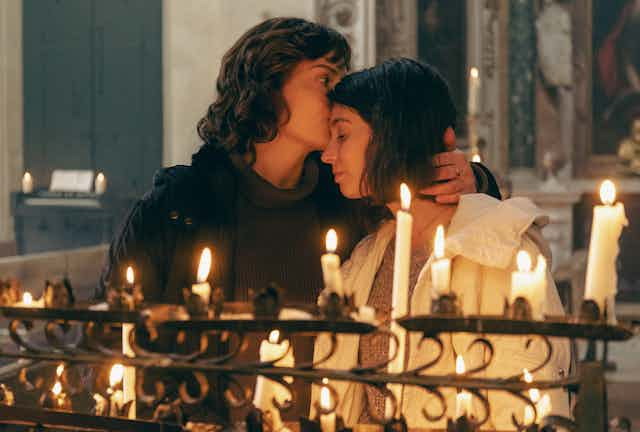The music accompanying the opening titles of the new Disney+ series The Good Mothers is a lullaby in the Calabrian dialect:
Ninna, ninna, ninna, ninna, neda The wolf eats the little lamb. Little lamb of mine, what did you do when you found yourself in the mouth of the wolf?
It is a dark and hidden message from a mother to her child before sleep. It serves as a reminder that the world is a dangerous place and your family are not always the people who will protect you. Sometimes, they are the ones who make it unsafe.
Disney’s latest contribution to the mafia genre, a six-episode TV drama series, is based on a book by British journalist Alex Perry. It’s a welcome and refreshing addition to the debate about the delicate role women play in Italian mafias.
Italian mafias are strange, fascinating organisations. They combine both highly sophisticated, modern criminal activities and money laundering scams with internal traditional values and codes that dictate behaviour to members.
The series deals specifically with the fates of three young mothers in the notorious Calabrian ‘Ndrangheta, a violent mafia that is both deeply embedded in the local community and has international reach. It is made up of more than 160 independent cosche, or clans, that exist across Calabria within a hierarchical structure. Each revolves around families with tight blood ties.
Women in Italian mafias
One of the innovative aspects of The Good Mothers is that it is framed as a story of “how feminism was key to bringing down Europe’s most powerful mafia”. And it is indeed an important contribution to our understanding of Italian mafias in part because it is a story about women, which is rare.
It’s incredibly difficult to research the roles women play in criminal groups because there is hardly any information available. When data does exist, it tends to adopt “a male gaze”. Most judicial or police sources are collected by men using their male values and gender assumptions, which colours the depiction of the women involved (and will inevitably pervade the narratives of those who use them).
When investigating mafias, there is a tendency to focus on the male-centric elements of operations – the leadership, the violence and the business. Accounts of women describe them either as victims of crime or as irrelevant extras.
The Good Mothers puts women at the centre of the action. Here is a detailed account of Calabrian mafia women who rebelled against the patriarchal, oppressive and violent mafia system by deciding to collaborate with the state to expose the perverse internal workings of their clans.
For one of the first times in English, we see the traumatic and painful life stories of real women – Lea Garofalo, Giuseppina Pesce and Maria Concetta Cacciola. All were born into but eventually escaped the mafia’s power.
The main theme of their testimonies is the sexism, misogyny and machismo that underpins the ‘Ndrangheta’s patriarchal framework. Gender dynamics, contradictions and power relationships are based on values such as family, honour, omertà (a code of silence), respect, violence and revenge.
Cacciola’s harrowing story illustrates how the mafia exploited her love for her children to get her to leave the witness protection programme. She then supposedly committed suicide by drinking acid in August 2011, a story no one believes. Her life represents the many dilemmas and difficulties involved in trying to extract oneself from the violent criminal underworld.
Pesce’s brave account adds complexity by underlining the way women in mafias can have agency – sexually, criminally, emotionally and socially. Pesce participated in the criminal activities of her clan, was outspoken and had an affair while her husband was in prison.
The character Anna Colace (who represents the real-life judge Alessandra Cereti) is another heroine. She is the brave anti-mafia prosecutor who takes on the mob by turning members and relatives into state witnesses. Through her investigations, she understands the power of the women in Calabrian cosche and how their desire to rebel can become a strength for the anti-mafia fight.
The missing mothers
The Good Mothers is a genuine attempt at explaining to an international audience how these real-life women and mothers sought to break free from the coercive control of the patriarchal Calabrian mafia system. Their decision became a historic moment that forced a change in the thinking around the ‘Ndrangheta. We learned that family structure, mothers and children are key.
Unfortunately, decades on from the events this series depicts, the ‘Ndrangheta is far from dead. Maybe, we are still missing a part of the puzzle. The Good Mothers missed an opportunity to denounce, highlight and analyse the role of Garofalo, Pesce and Cacciola’s own mothers, who endorsed the patriarchal values of the violent mafia system by manipulating these young women and by trying to stop them from rebelling.
This TV series only tells part of the story because it is based on a book that was itself a reconstruction of judicial investigations and interviews. A male gaze therefore remains.
While there are nuances, women are still largely depicted as victims of the mafia male patriarchy. Absent are discussions about the male victims of the ‘Ndrangheta or the powerful and determined matriarchs who reinforce the structures that allow the ‘Ndrangheta cosche to flourish.
In the book and consequently in the TV series, the mafia’s coercive control is too often portrayed as male when to fully understand it, we must also include the other women who remain in the shadows. It is these women who are the foundation of the ‘Ndrangheta and who should not be overlooked. Mafia oppression is not only male but also female. The essence of the ‘Ndrangheta is not only the good mothers but all the mothers.

